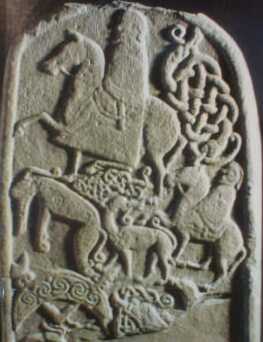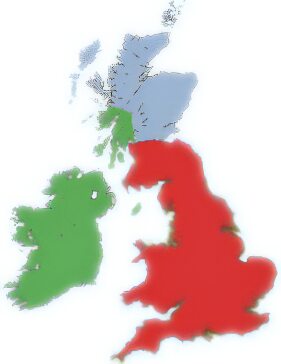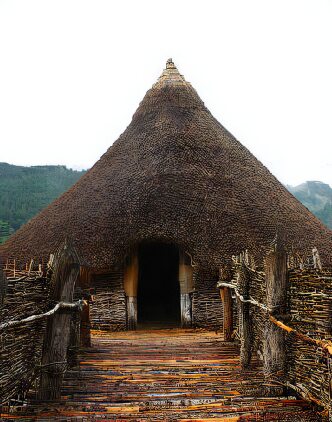Origins of the Picts
By the fourth century AD, the predominant race in northern Scotland were the Picts, the name was coined by the Romans who referred to them as 'Picti' meaning 'painted ones', which referred to the Pictish custom of either tattooing their bodies or covering themselves with warpaint. The Irish referred to them as Cruithni, meaning "the people of the designs". What they called themselves has gone unrecorded.
Pictish Stone
The Picts were descendants of the Iron Age people of northern Scotland, believed to have originated in Iberia as hunter-gatherers, they moved through lower Britain and entered Scotland around 7000BC. Recent DNA tests have proven the Picts were closely related to the Basques of northern Spain. The connections between northern Britain and Celtic Spain are supported by many myths and legends. The dolmens, standing stones and the trail of "cup and ring" designs carved on stones by the prehistoric people of Iberia make their way from Spain and Portugal and northern France to Ireland and Scotland and represent the earliest evidence of the movement of prehistoric man from Iberia to Britain.
Conflict with the Romans
The earliest surviving reference to the Picts dates from 297 AD. In a poem praising the Roman emperor Constantius Chlorus, the orator Eumenius recorded that the Britons were already accustomed to the semi-naked"'Picti, fierce warrior tribes, north of the Antonine wall, as their enemies."
The Romans referred to Scotland as Caledonia, a name derived from the Pictish tribe Caledonii. By AD 80 the Romans had succeeded in subduing the tribes of Britons which occupied the area south of the Forth and Clyde, but those to the north proved harder to conquer.
The Roman historian Ammianus Marcellinus recorded ' ...the Picts, divided into two tribes called Dicalydones and Verturiones. are roving at large and causing great devastation. In the early-600s, the Spanish bishop and encyclopaedist, Isidore of Seville wrote of them:-'the Picts, whose name is taken from their bodies, because an artisan, with the tiny point of a pin and the juice squeezed from a native plant, tricks them out with scars to serve as identifying marks, and their nobility are distinguished by their tattooed limbs.'
Gnaeus Julius Agricola advanced to the River Tay, constructing a legionary fortress at Inchtuthil, north of Perth. The Picts, under the leadership of Calgacus ('the Swordsman'), met the Romans under Julius Agricola, at the Battle of Mons Graupius in 84 A.D. when the Romans marched on their main granaries. Prior to this, the Picts had avoided open battle, preferring to carry out guerilla-style raids. Tacitus records a speech which he claims to have been made by Calgacus before the battle in which he describes the Romans as: "Robbers of the world, having by their universal plunder exhausted the land, they rifle the deep. If the enemy be rich, they are rapacious; if he be poor, they lust for dominion; neither the east nor the west has been able to satisfy them. Alone among men they covet with equal eagerness poverty and riches. To robbery, slaughter, plunder, they give the lying name of empire; they make a solitude and call it peace.
An account of the battle was left by Tacitus, the Roman historian and son-in-law of Julius Agricola '..men and horses were carried along in confusion together, while chariots, destitute of guidance, and terrified horses without drivers, dashed as panic urged them. the earth reeked with blood. The Picts were routed by Roman cavalry and after the battle, many succeeded in escaping into the hills and Agricola withdrew. The actual site of the battle is not known.
Other races in Scotland
The Scots, who were Gaelic Celts, arrived later, they crossed the sea from Northern Ireland in the third and fourth centuries A.D. taking over the area of the West Highlands, which they termed Dalraida.
The Britons of Strathclyde, another Celtic race, known as Brythonic Celts, controlled the south-west from the Clyde to the Solway and into Cumbria. To this melting pot was added the Vikings, of Norway and Denmark, originally raiders who became settlers, who largely occupied the islands of Shetland and Orkney and lastly the Angles, who came north across the border from England to inhabit the Scottish lowlands.
The Angles from Northumbria settled in south-eastern Scotland in the region between the Firth of Forth to the north and the River Tweed to the south.
The Pictish Kingdoms
Pictland, Pictavia or Cruithentuath, comprised all of modern Scotland north of the Forth and Clyde except for Dalriada (Argyll and other western areas). The Brythonic Celts covered the southern territories of the Kingdom of Strathclyde and also held the Manaw Gododdin territory around Stirling.
Picts, Scots and Britons
In later periods several Pictish kingdoms developed, ruled over by seperate kings:-
Cait, or Cat, situated in modern Caithness and Sutherland
Ce, situated in modern Mar and Buchan
Circinn, possibly located in modern Angus and the Mearns
Fib, the modern Fife.
Fidach, possibly near Inverness
Fotla, modern Atholl (Ath-Fotla)
Fortriu, centered around Moray
Myth tells us that the first Pictish king Cruithne had seven sons who gave their names to the seven Pictish subkingdoms. For much of the recorded history of the Picts, Fortriu seems to have been the dominant kingdom. There is evidence to suggest that a Pictish kingdom also existed in Orkney.
Forteviot was a residence of the Pictish kings of Fortriu. King Kenneth mac Alpin (Cináed mac Ailpín) died in 858 at the 'palace' of Forteviot. The palace formerly stood on Haly Hill, on the west side of the modern village of Forteviot.
Pictish society was militaristic and aristocratic and had several classes, including cavalry and footmen, a peasantry, some of whom were bonded to the land, all ruled by tribal chiefs and kings. The origins of this society lie in the Celtic Iron Age of the area.
The first king who appears in several early sources is Bridei son of Maelchon, often called by the anglicised name of 'Brude', who became king around 555AD and died around AD 586. Bridei's kingdom of Pictland stretched north from the land between the Forth and the Clyde. He defeated the Scots, under King Gabranin in battle and laid waste to the Scottish holdings in the west. He was visited by st. Columba at the great Pictish hill-fort of Craig Phadrig.
The Pictish language
The Pictish language has failed to survive to the present day. Few clues have been left behind as to this ancient language, apart from a few Pictish inscriptions. They probably acquired their alphabet from the Dalraida Scots. Their mysterious artwork was particularly distinctive, the symbolism of which remains undeciphered by archaeologists, its meanings shrouded in the mists of time.
Several conflicting theories have been advanced regarding the Pictish language:-
(i) Pictish was an Insular Celtic language allied to the P-Celtic (Brythonic) languages (similar to Welsh, Cornish, Cumbric, and Breton)
(ii) Pictish was an Insular Celtic language linked to the Q-Celtic (Goidelic) languages (Irish Gaelic, Scottish Gaelic and Manx)
(iii) Pictish was a Germanic language allied to Old English, the predecessor to the Scots language
(iv) Pictish was a Pre-Indo-European language, a relic of the Bronze Age
The current consensus is that Pictish was a P-Celtic (Brythonic) language that came under increasing influence by the Gaelic language of Dál Riata from the fifth century until its eventual replacement.
The evidence of place names and personal names strongly implies that the Picts spoke an Insular Celtic language which was related to the Brythonic language of old Welsh. Celtic elements such as 'Aber', meaning a confluence or mouth of a river, are directly related to the Welsh Celtic language. The classic Pictish prefix 'Pit', found today in farm and village names such as Pittenweem and Pitlochry, may also reflect a Celtic word meaning 'a piece of' (land). Tribal names are known from Roman sources and a proportion are Celtic. It is recorded that St. Columba required interpreters to speak to the Pictish King King Bridei, clear evidence that the Picts did not speak the Gaelic Celtic language of the Irish and Scots.
A number of Ogham inscriptions have been argued as not being Celtic, and from this, it has been theorised that non-Celtic languages were also in use in Scotland at this time.
Pictish Stones
The Picts are probably most famous for the carvings of symbols on their stones, the most visible remaining evidence of the Picts. Pictish Symbol stones have been found throughout Scotland, although their original locations are concentrated largely in the North East of the country in lowland areas, the Pictish heartland. Only a few stones are still located at their original sites, most have been moved to museums or other protected sites.
Reconstructed Crannog at Loch Tay
The purpose and meaning of the stones are only slightly understood. 40 different symbols have been identified on these stones, which fall into three distinct groups. The first group of symbols, perhaps the most distinctive aspect of Pictish culture, are the abstract, or geometric designs: extraordinary, recurrent and consistent. The second group is made up of real or mythical creatures. The real creatures are those which the past were native to Scotland, such as snakes, eagles, wolves and bears. But the most common animal symbol is a strange creature bearing a pointed snout, curling antennae and curved, fin-like limbs, which is known as the 'Pictish beast'. The third group is of real life objects, often found in pairs mirror and comb; hammer and anvil; tongs and shears. These symbols are often featured towards the foot of a stone. It is thought they may qualify the meaning of any symbols carved above.
Society and Culture
The Picts may have been unusual in operating a matrilineality based society, with land, property and position passing through the female line, which is how Kenneth McAlpin, first King of Scotland, the son of a Pictish princess, came to occupy the throne.
Archaeology has provided much evidence on the culture of the Picts. In common with most peoples in the north of Europe in the Dark Ages, the Picts were farmers living in small communities. Brochs, although built in the Iron Age, with construction ceasing around 100 AD, seem to have continued in use into the Pictish period. Crannóg, which may have their origins in Neolithic Scotland, they were used as defensive dwellings and were still in use in the time of the Picts. They were constructed by driving timber piles into shallow parts of the loch bed, which then became the supporting frame for a roundhouse. More than 20 submerged crannogs have been discovered in Loch Tay. An example has now been reconstructed on the south side of the loch at the Scottish Crannog Centre. The most common type of buildings used by the Picts were roundhouses and rectangular timber halls.
A variety of Pictish artefacts carved in silver and gold, enamel and stone have been discovered. They depict men and beasts and often feature intricate patterns. By the sixth century the style reveals the influence of Celtic and classical designs.
Brooch from Pictish Treasure found at St. Ninian's, Shetland
A hoard of Pictish silver was unearthed on St Ninian&rsquo's Isle in Shetland in 1958 by a schoolboy, Douglas Coutts, who was taking part in excavations of the ancient church that had once existed on the island. The hoard contained eight decorated bowls, silver spoons and 12 penannular brooches of silver gilt. The hoard may have been hidden to conceal it from Viking raiders. It was found in a wooden box that had been buried beneath a slab marked with a cross. It is generally assumed that the treasure was hidden beneath the floor of an earlier chapel.
Conversion to Christianity
The Picts were converted to Christianity by St. Columba (Colum Cille), who was born around 521 in Ireland. St. Columba established the monastery on the island of Iona in 563, in an area controlled by the Dál Riata (The Scots). The biographer of Columba, Adomnan relates that Columba made several journeys into Pictavia. It is reputed that during missions along the Great Glen by Columba and his followers to preach among the Picts, the Loch Ness Monster had its first recorded historical debut. Columba visited the court of the Pictish King, Bridei, son of Maelchon, on several occasions. The gradual conversion of the Picts to Christianity and the spread of Columban monasteries throughout Pictland had been accomplished before the end of the seventh century.
After dominating most of Scotland for at least 600 years, the Picts were gradually absorbed into the nation of Alba in around 900. Their disappearance was partly the result of Viking invasions, but mainly by their political takeover by a Gaelic dynasty.
Pictish DNA
The distinctive DNA marker of the Pictish tribes of Scotland has been identified. The genetic footprint of the ancient Picts are still present in Scotland, S145-Pict, the unique grouping of their Y-chromosome is carried by 7 per cent of Scottish men and has a wide distribution over the ancient Pictish areas of northern Scotland. Scientists were able to isolate the unique Pictish DNA strands from 1,000-year-old bone fragments found in ancient burial grounds.
DNA studies carried out in Scotland suggest an ancient story. Most Scots are descendants of the original hunter-gatherers who arrived in Scotland after the close of the last Ice Age. Several people, particularly in the western islands, are descended from farmers who arrived from the eastern Mediterranean during neolithic times.
